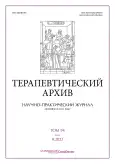Features of vectorcardiograms in patients with hypertension complicated by chronic heart failure with reduced left ventricle ejection fraction
- Authors: Sakhnova T.A.1, Blinova E.V.1, Yurasova E.S.1, Uskach T.M.1, Blinova N.V.1, Aidu E.A.2, Trunov V.G.2, Saidova M.A.1
-
Affiliations:
- Chazov National Medical Research Center of Cardiology
- Kharkevich Institute for Information Transmission Problems
- Issue: Vol 94, No 9 (2022)
- Pages: 1067-1071
- Section: Original articles
- URL: https://journals.rcsi.science/0040-3660/article/view/105704
- DOI: https://doi.org/10.26442/00403660.2022.09.201843
- ID: 105704
Cite item
Full Text
Abstract
Aim. To explore the features of vectorcardiograms (VCG) of patients with essential hypertension complicated by chronic heart failure with reduced left ventricular ejection fraction (CHFrLVEF).
Materials and methods. We analyzed VCGs of 70 hypertensive patients with CHFrLVEF and 275 hypertensive patients without clinical signs of CHF and with LVEF>50%. We assessed the presence of rhythm and conduction disturbances, and the parameters of the synthesized VCG, i.e., module of the maximum QRS vector, planarity index of the spatial QRS loop (P/S), and spatial angle between the integral QRS and T vectors (sQRS-Ta).
Results. In hypertensive patients with CHF, certain conditions were detected more often as compared with hypertensive patients without CHF, i.e., atrial fibrillation (AF) in 52.9% vs 5.1%; p<0.0001, and left bundle branch block (LBBB) in 38.6% vs 0.4%; p<0.0001. The module of the maximum QRS vector and sQRS-Ta were significantly greater and P/S was significantly less in VCGs of patients with CHF. ROC-analysis showed that the presence of AF and LBBB just as VCG parameters assessed in this study provide clear discrimination between hypertensive patients with or without CHF both in the group as a whole and in the subgroups (1) without LBBB, (2) with sinus rhythm, and (3) with AF. sQRS-Ta was the most informative parameter (threshold >137°, sensitivity 91%, specificity 92%). The P/S indicator at the optimal threshold value ≤0.92 was characterized by lower specificity (68%) with rather high sensitivity (79%).
Conclusion. AF, LBBB, increased module of the maximum QRS vector and sQRS-Ta, and decreased P/S index are present in hypertensive patients with CHFrLVEF as compared with patients without CHF.
Full Text
##article.viewOnOriginalSite##About the authors
Tamara A. Sakhnova
Chazov National Medical Research Center of Cardiology
Author for correspondence.
Email: tamara-sahnova@mail.ru
ORCID iD: 0000-0002-5543-7184
канд. мед. наук, ст. науч. сотр. лаб. ЭКГ Института клинической кардиологии им. А.Л. Мясникова
Russian Federation, MoscowElena V. Blinova
Chazov National Medical Research Center of Cardiology
Email: tamara-sahnova@mail.ru
ORCID iD: 0000-0001-8725-7084
канд. мед. наук, науч. сотр. лаб. ЭКГ Института клинической кардиологии им. А.Л. Мясникова
Russian Federation, MoscowElena S. Yurasova
Chazov National Medical Research Center of Cardiology
Email: tamara-sahnova@mail.ru
ORCID iD: 0000-0002-4640-5578
канд. мед. наук, вед. науч. сотр. научно-экспертного отд. Института клинической кардиологии им. А.Л. Мясникова
Russian Federation, MoscowTatiana M. Uskach
Chazov National Medical Research Center of Cardiology
Email: tamara-sahnova@mail.ru
ORCID iD: 0000-0003-4318-0315
д-р мед. наук, вед. науч. сотр. отд. заболеваний миокарда и сердечной недостаточности Института клинической кардиологии им. А.Л. Мясникова
Russian Federation, MoscowNataliya V. Blinova
Chazov National Medical Research Center of Cardiology
Email: tamara-sahnova@mail.ru
ORCID iD: 0000-0001-5215-4894
канд. мед. наук, ст. науч. сотр. отд. гипертонии Института клинической кардиологии им. А.Л. Мясникова
Russian Federation, MoscowEduard A.I. Aidu
Kharkevich Institute for Information Transmission Problems
Email: tamara-sahnova@mail.ru
ORCID iD: 0000-0001-9505-4404
канд. техн. наук, ст. науч. сотр. лаб. теории передачи информации и управления
Russian Federation, MoscowVladimir G. Trunov
Kharkevich Institute for Information Transmission Problems
Email: tamara-sahnova@mail.ru
ORCID iD: 0000-0002-6084-1608
канд. техн. наук, вед. науч. сотр. лаб. теории передачи информации и управления
Russian Federation, MoscowMarina A. Saidova
Chazov National Medical Research Center of Cardiology
Email: tamara-sahnova@mail.ru
ORCID iD: 0000-0002-3233-1862
гл. науч. сотр. отд. ультразвуковых методов исследования Института клинической кардиологии им. А.Л. Мясникова
Russian Federation, MoscowReferences
- Al Hinai G, Jammoul S, Vajihi Z, Afilalo J. Deep learning analysis of resting electrocardiograms for the detection of myocardial dysfunction, hypertrophy, and ischaemia: a systematic review. Eur Heart J Digit Health. 2021;2(3):416-23. doi: 10.1093/ehjdh/ztab048
- Yao X, Rushlow DR, Inselman JW, et al. Artificial intelligence-enabled electrocardiograms for identification of patients with low ejection fraction: a pragmatic, randomized clinical trial. Nat Med. 2021;27(5):815-9. doi: 10.1038/s41591-021-01335-4
- Olesen LL, Andersen A. ECG as a first step in the detection of left ventricular systolic dysfunction in the elderly. ESC Heart Fail. 2016;3(1):44-52. doi: 10.1002/ehf2.12067
- Surawicz B, Childers R, Deal BJ, et al. AHA/ACCF/HRS recommendations for the standardization and interpretation of the electrocardiogram: part III: intraventricular conduction disturbances: a scientific statement from the American Heart Association Electrocardiography and Arrhythmias Committee, Council on Clinical Cardiology; the American College of Cardiology Foundation; and the Heart Rhythm Society. Endorsed by the International Society for Computerized Electrocardiology. J Am Coll Cardiol. 2009;53(11):976-81. doi: 10.1016/j.jacc.2008.12.013
- Nwabuo CC, Vasan RS. Pathophysiology of Hypertensive Heart Disease: Beyond Left Ventricular Hypertrophy. Curr Hypertens Rep. 2020;22(2):11. doi: 10.1007/s11906-020-1017-9
- Bacharova L. Missing Link between Molecular Aspects of Ventricular Arrhythmias and QRS Complex Morphology in Left Ventricular Hypertrophy. Int J Mol Sci. 2019;21(1):48. doi: 10.3390/ijms21010048
- Reinier K, Aro AL, Uy-Evanado A, et al. Electrical surrogate for detection of severe left ventricular systolic dysfunction. Ann Noninvasive Electrocardiol. 2018;23(6):e12591. doi: 10.1111/anec.12591
- Bacharova L, Szathmary V, Kovalcik M, Mateasik A. Effect of changes in left ventricular anatomy and conduction velocity on the QRS voltage and morphology in left ventricular hypertrophy: a model study. J Electrocardiol. 2010;43(3):200-8. doi: 10.1016/j.jelectrocard.2009.07.014
- Бойцов С.А., Гришаев С.Л., Ласточкин И.Г., Пинегин А.Н. Диагностическая эффективность пространственных показателей компьютерной векторкардиографии для оценки гипертрофии левого желудочка сердца. Артериальная гипертензия. 2003;9(4):142-4 [Boitsov SA, Gizhayev SL, Lastochkin IG, Pinegin AN. Diagnostic effectiveness of spatial indices of computed vectorcardiography for evaluation of left ventricular hypertrophy. Arterial’naya gipertenziya. 2003;9(4):142-4 (in Russian)]. doi: 10.18705/1607-419X-2003-9-4-142-144
- Elffers TW, Trompet S, de Mutsert R, et al. Electrocardiographic Detection of Left Ventricular Hypertrophy; Adding Body Mass Index and Spatial QRS-T Angle: A Cross-Sectional Study. Cardiol Ther. 2019;8(2):345-56. doi: 10.1007/s40119-019-00151-9
Supplementary files









